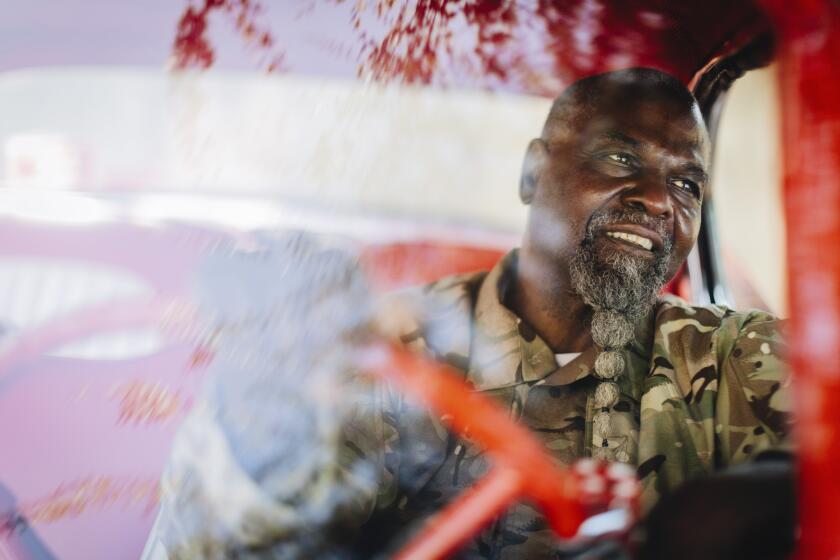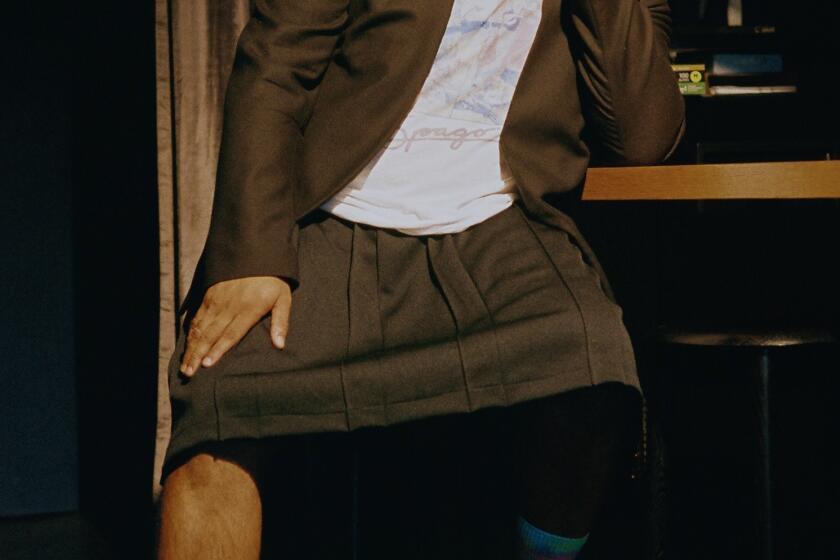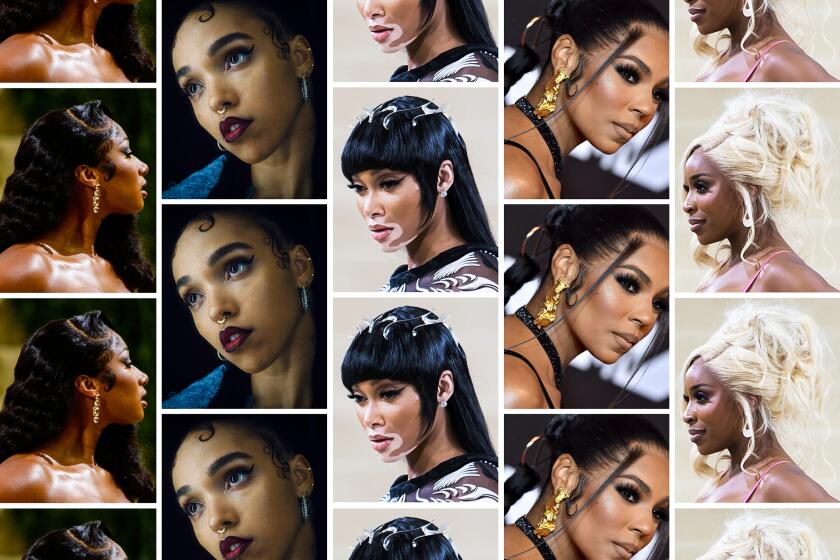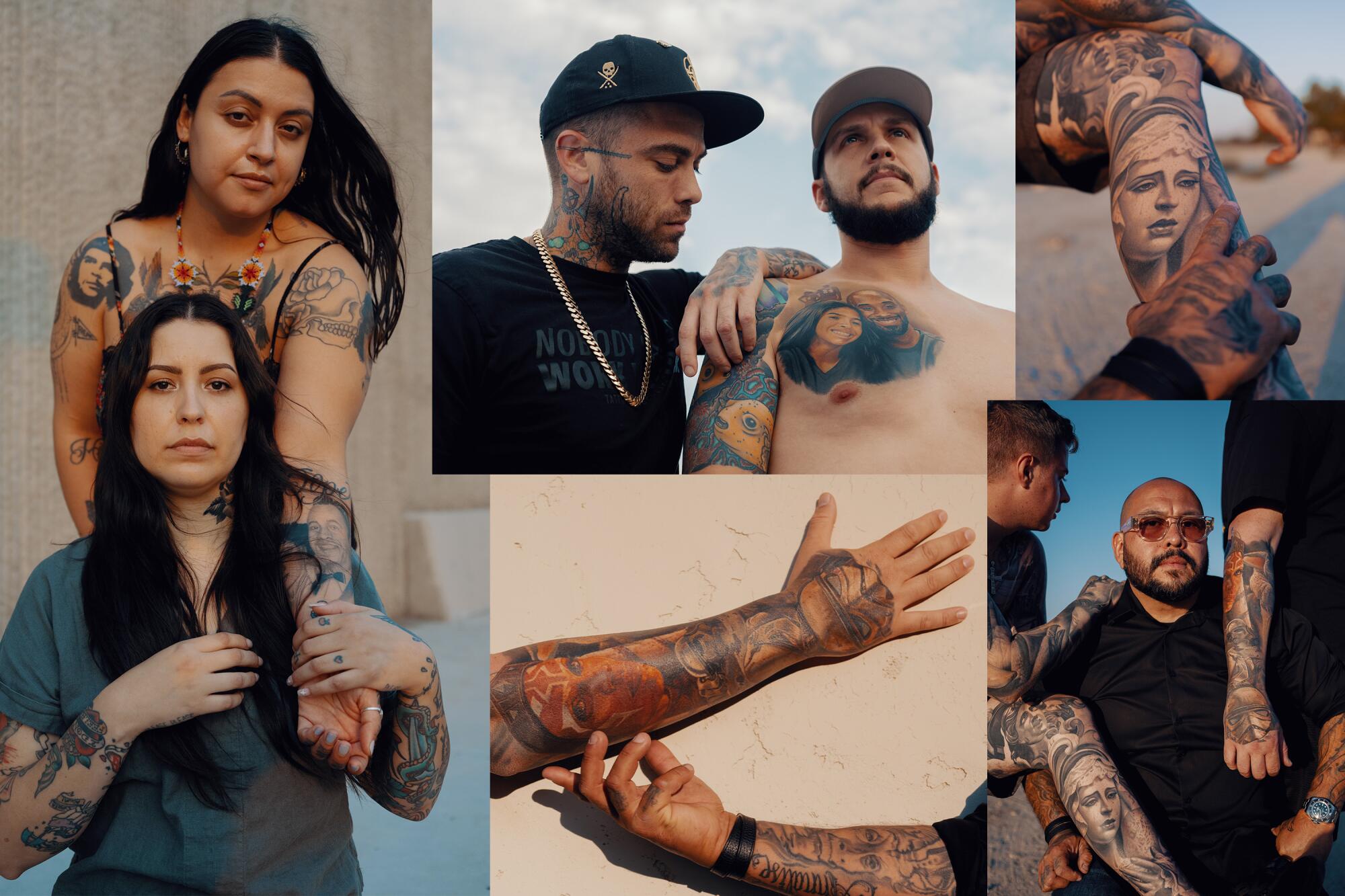
- Share via
This story is part of Image issue 5, “Reverence,” an exploration of how L.A. does beauty. See the full package here.
The first time I grasped the meaning of tattoo portraiture was in the mid-2000s, watching “L.A. Ink” on TLC. This was one of the first reality shows that depicted the world of tattooing — launching many of its kind — and it offered me a glimpse into a world that felt far away in both time and culture. Tattoos weren’t as ubiquitous or acceptable then. On the occasion of the show’s launch, on Aug. 7, 2007, I wasn’t legally allowed to even think about getting my own ink.
Still, these were the episodes I’d wait for: Where tears were shed by a real-life character onscreen. Where a client would come in with a photograph grasped tightly to their chest, voice cracking in the way that it does when someone is about to share something excruciatingly personal. Sometimes the photographs were old and classic, of a deceased loved one with tightly coiffed hair and perfect makeup. Other times, it was a candid shot of someone’s very much alive mom, radiating warmth. There were the photos of idolized celebrities. The ones of kids who you knew were gone — their grieving parents wanting to memorialize a life that was cut short.
These were more than just photographs. And in this moment, the tattoo artists were more than just tattooers.
They were witnesses to grief, joy, anticipation. They were investigators, getting answers to the important questions such as what does this person in the photograph mean to you? What kind of life did they live? What’s their legacy? What are your most cherished memories with them? Why — of all the ways to honor a person — are you putting their face on your body forever? They did all of this while putting ink to skin, while shading in the portrait subject’s eyes so that they sparkled like they did in real life, while ensuring that the smile line next to the mouth was curved just so.
Watching it happen seemed like equal parts magic and voyeurism — this intimate energy exchange that rarely happened between loved ones, let alone an artist and their canvas, playing out onscreen. With the portrait episodes, it was always about so much more than just tattooing. It was about love. Holding space for it, showing it and ultimately preserving it on skin forever. It was different from watching a live painter create a portrait on stretched cloth, or a sculptor carving someone’s likeness out of clay. This was more personal, more high-stakes.
Image Reverance stories
Mr. Wash remembers that time Drake slid into his DMs
Dave Schilling learns what it means to be beautiful in Comme Des Garçons
Jean Chen Ho explores grief through IG thirst traps
Darian Symoné Harvin dives deep into sideburn style
Texas Isaiah shows how photography doesn’t have to perpetuate visual violence
On YouTube, there’s a clip from an episode of “L.A. Ink” where a baby-faced Nikko Hurtado tattoos a man named Mark with a portrait of his son, Sam, who died of cystic fibrosis at 20 years old. This was before Hurtado became the celebrity portrait artist known for massive color realism portraits — his work instantly recognizable on the bodies of Drake, Diddy and Dwayne “The Rock” Johnson. Mid-shade, Hurtado nods in affirmation as Mark unloads the story of his son. “His suffering made him a much stronger person,” Mark said. To which Hurtado replied, without skipping a beat: “And in turn made you stronger, huh?”
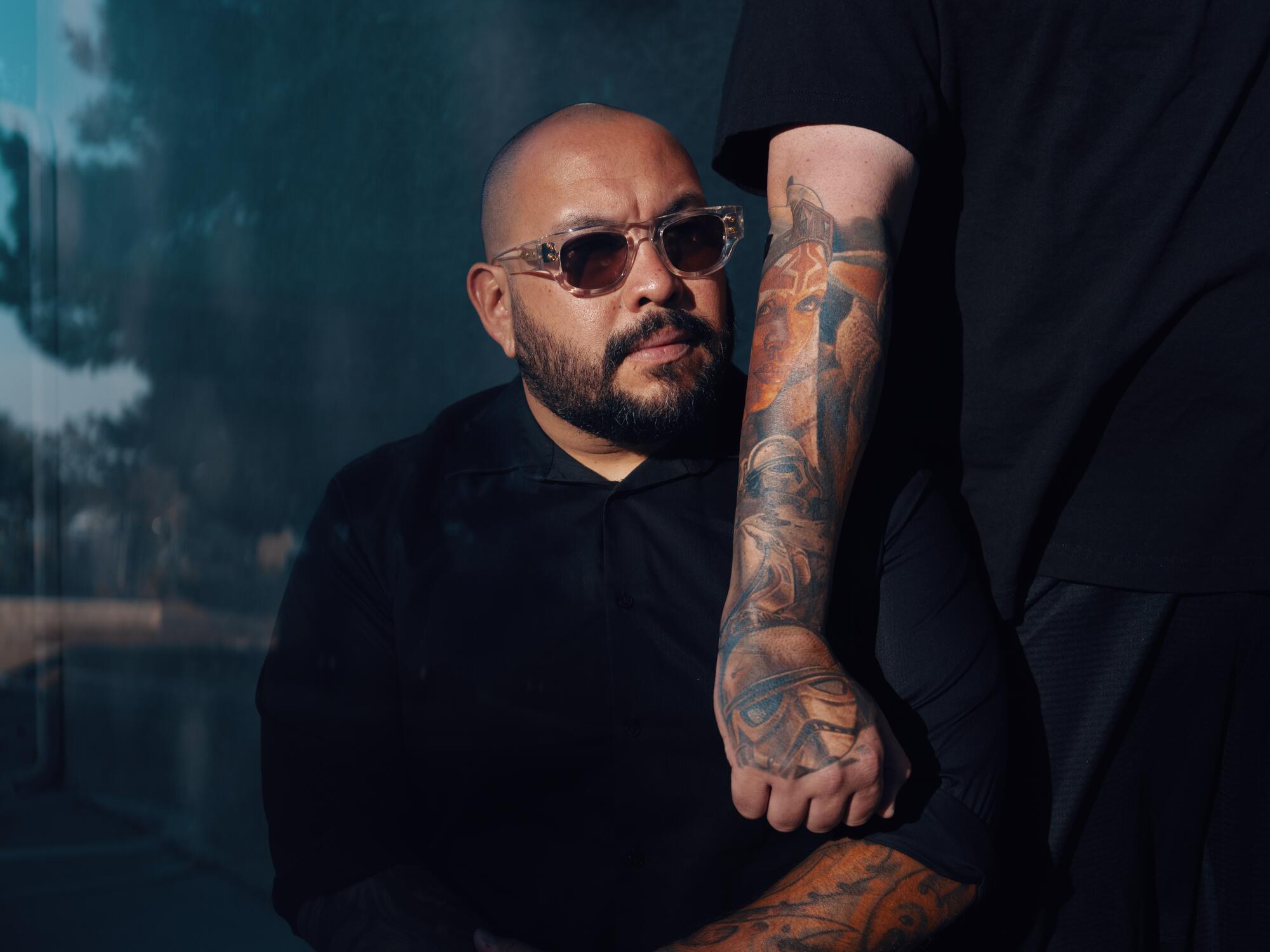
More than a million-and-a-half Instagram followers, worldwide fame and too many celebrity clients to count later, and Hurtado says that these are still the most meaningful portrait tattoos he does: the ones that feel essential to people’s grieving process. “I’ve watched people get forearm tattoos of their children and almost cradle them — almost as if they’re holding their child,” he says. “Those are the most important tattoos I make.”
When Nipsey Hussle died, L.A. grieved for what felt like an eternity. It’s still grieving — mention his name in any conversation and you’ll feel the tension rising up from people’s throats. It was only a few weeks after his death in 2019 that Hurtado was sitting across from The Game, the Compton rapper formerly known as Jayceon Terrell Taylor, and tattooing a portrait of his fallen friend above his sternum. It was a coverup on an older portrait of Barack Obama. Hope had been replaced by love.
“With this specific tattoo, all [The Game] kept saying [was], ‘Man, you know, Nipsey went through worse so I’m gonna sit here and gruel it out,’” Hurtado remembers. “I think a lot of people deal with trauma and the pain through that. It’s something that’s therapeutic.”
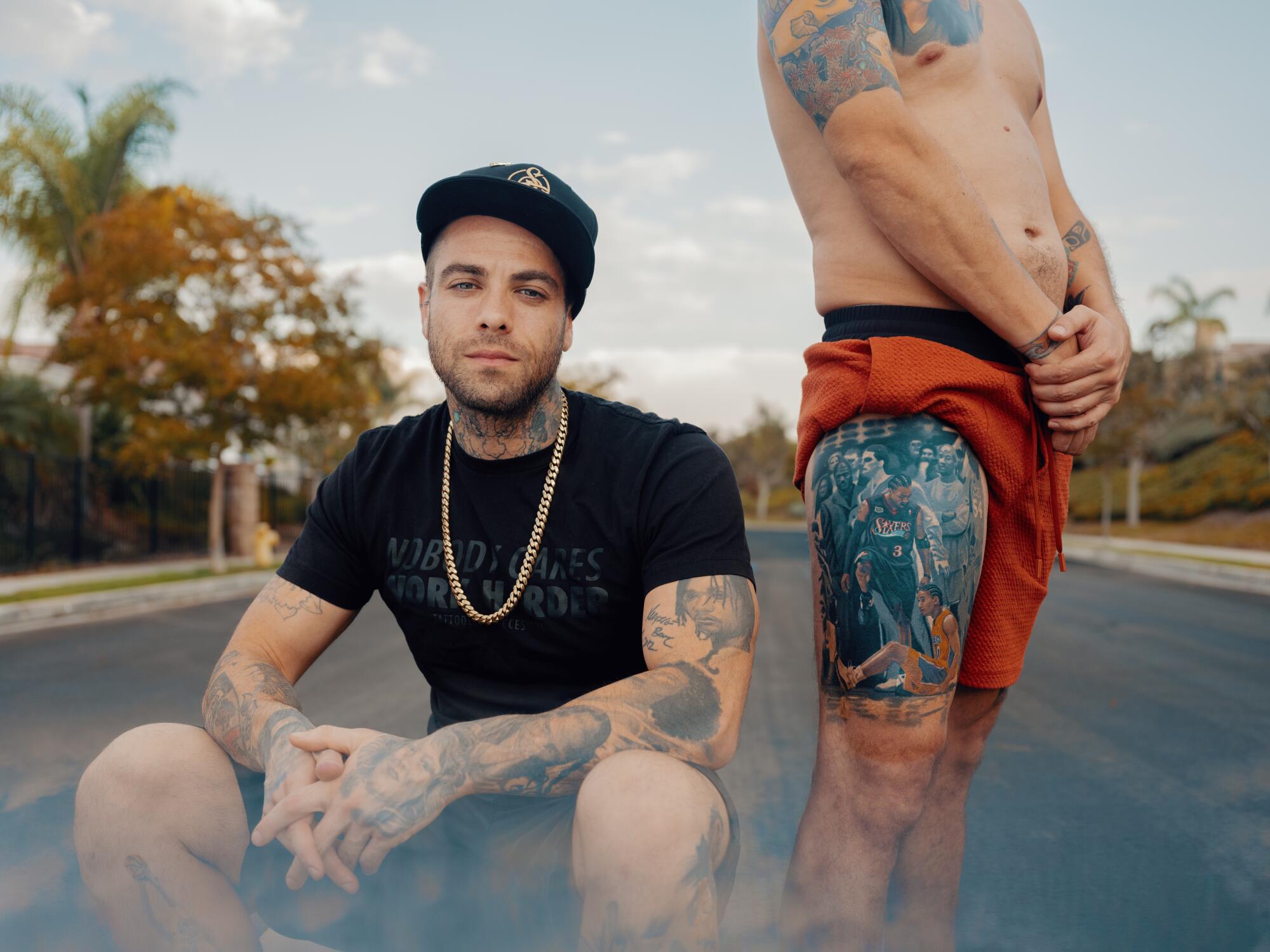
Steve Butcher knows something about grieving L.A. icons through ink. His specialty — what people fly in from all over the world to see him for — are his Kobe Bryant tattoos. Hyper-realistic, deeply colorful renditions of Kobe in flight. Kobe beaming with his NBA championship trophy. Kobe after scoring, mouth open in a primal yell while pulling at his own collar. Kobe biting on his purple and gold jersey. Kobe. Kobe. Kobe. Photocopied onto the skin of customers forever. Butcher has done so many Kobe Bryant tattoos (50) that he has his face memorized. Butcher himself has four Kobe tattoos, three of which he had other artists tattoo on him, each lending their own interpretation, and one that he tattooed on his right leg. (“Seven hours work, nine years ago,” he says.) Butcher moved to Southern California from his native New Zealand two years ago to hopefully one day tattoo his icon, but he never got the chance due to Kobe’s untimely death on Jan. 26, 2020.
“It’s crazy how a sports person or someone that you idolize can actually inspire you and change your mode of thinking and make you grind harder,” Butcher says. “People connect to a certain entity and are about everything that they’re about. It’s not just like, ‘Oh, Kobe is so cool.’ It means something more.”
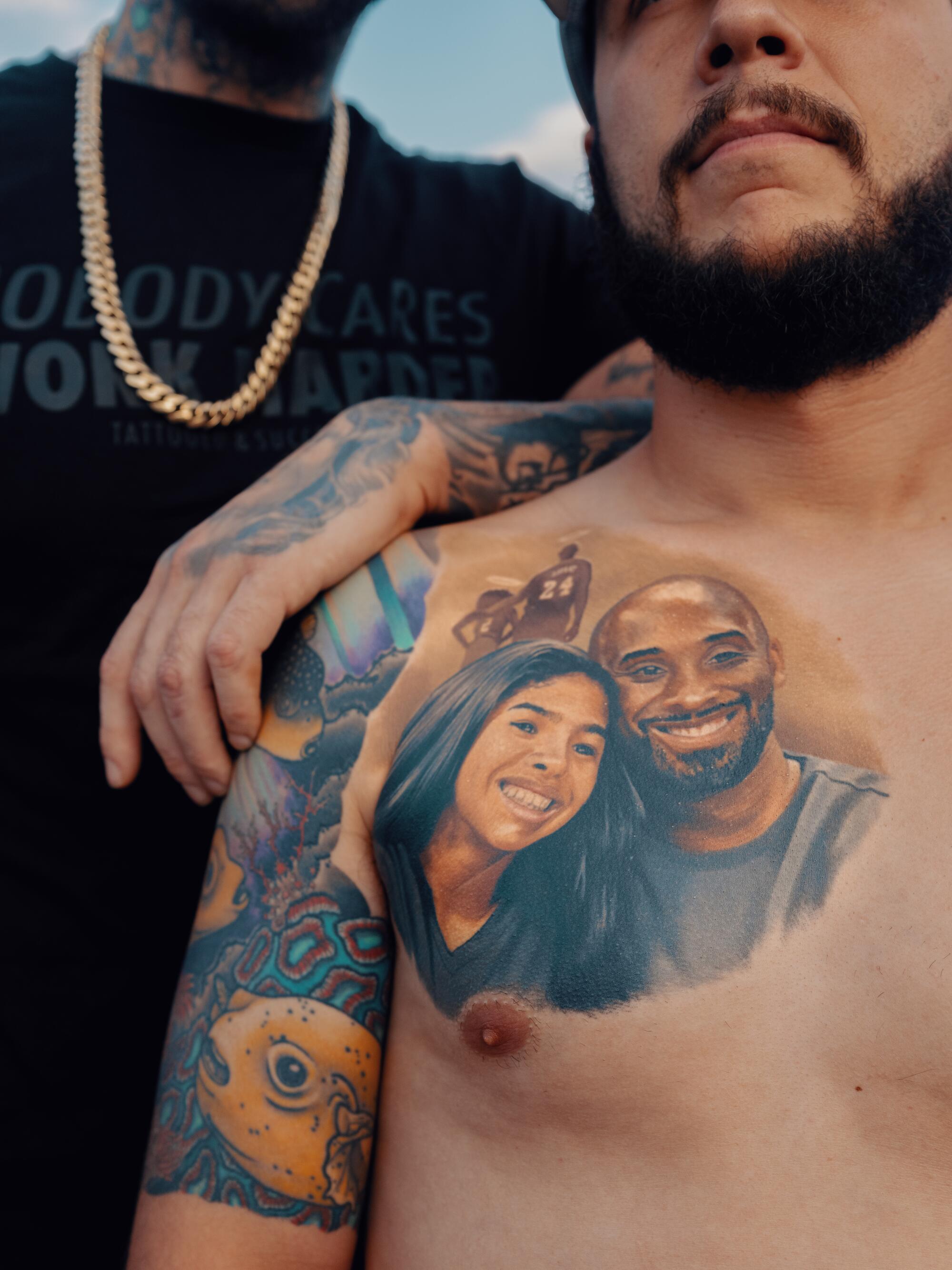
It makes sense, I guess, to put someone’s face on your body that you know and that you have memories with. But what about when those memories and that knowing is one-sided? Hurtado has tattooed portraits of most major celebrities and famous characters on his clients. Lana Del Rey. Snoop Dogg. Mike Tyson. Mac Miller. Robert De Niro. Leonardo DiCaprio. “It’s more of a symbol of they impacted their life,” he explains of this kind of piece. “There is also a difference between somebody that’s a collector — they’ll find their favorite movie and be like, ‘It’s not that big of a deal. I just want a tattoo from you.’ It’s just as easy as that.”
Each portrait tattoo is different from the next — there are various styles and levels of detail. Black and gray, color. Realistic, illustrated. Small, large. The motivations can vary too. Not all portrait tattoos are memorials and they don’t always have a sad story attached to them. Oftentimes they can be odes to people who are still here. You have been warned not to get a tattoo of a significant other’s name on your arm; but a face might be a more sincere profession of love.

Arlene Salinas could never forget the first portrait she ever did. It was on her brother, her first guinea pig, and it was of their grandfather. They chose the photograph together: an image that reflected the one they saw when they closed their eyes and thought of him. He was wearing his signature huge aviators from the ’70s that doubled as reading and sunglasses with the flip-up top.
Fulton Leroy “Mr. Wash” Washington is putting his story to the best use for the world.
“At first he shook his head a little [in disapproval] — because you know, my family’s Catholic Mexican,” remembers Salinas, a tattooer at Three Kings Tattoo in Highland Park. “But then he teared up a little and gave my brother a hug. He was like, ‘But no more.’”
To get the face of someone you love on your body might seem like the most extreme way to show love — but after perfecting the warm, detailed black and gray portraits she’s known for, Salinas says it also seems like the most natural. “Sometimes people are really fond of something and they just want to honor the shit out of it, and put it on their body” she says. “It’s just human nature to want to stand on top of a mountain and profess your love for something.”
Portraiture as practice, tattooers say, is unique from other forms of tattooing — not necessarily more difficult, just different. Everything from the level of time, specificity of skill and connection to the inner workings of their clients’ heart and mind. Salinas can take upward of three hours doing a realistic black and gray piece, depending on detail. Hurtado’s works can take anywhere from four to eight hours and Butcher can spend four to 12 hours on his portraits. It’s hard on the body and can slash any chance at a work-life balance if you’re doing them back to back. But mostly, it’s a vibe thing. Sitting with someone for so many hours in such an intimate setting — with their head inches away from someone’s body part that they’re tattooing — is closer than most friends sit the majority of the time, Salinas notes. It’s an energy exchange unlike anything else.
“That sort of invasion of space breeds vulnerability,” she says, “People tend to open up to us a lot. It’s part of our job to sit there and listen. They’re trusting us to mark their body forever — it comes with the territory.”
It’s a cliché to say that tattoo artists — or nail artists or hairstylists or your eyebrow lady — are your “therapists.” But there is something about doing portrait tattoos — something about the physical pain and act of sitting across from another person, sharing space and emotion — that people have described time and time again as therapeutic. “A lot of times you have conversations and hear stories from your client that probably not even their spouse or partner hear,” Hurtado says. “They’re alone there and they’re just giving it up, just letting go of something. They cry. It’s a lot.”
Hurtado, founder of the Black Anchor Collective with shops in Hollywood and Hesperia, calls himself an empath. He can’t help but get wrapped up in the world of his clients, in their stories. “I don’t know how to shut that part of me off, so I become really drained,” he says. The only useful way he’s found to disconnect is by living in the desert — escaping the noise there. “When I go home late at night, everyone’s asleep. There’s no sound. I can actually find my center, hone in on that and rebuild and recharge.”
While tattoo portraiture is its own niche in the tattoo world, it’s also part of a bigger tradition in art. Painted, drawn, sculpted or photographed, portraiture has always been, at least implicitly, about the relationship between artist and subject. Portraits capture the physicality of a subject’s spirit — how it moves, matures, releases, feels. Features like facial expressions — indentations on the cheek or the brow; dilation of the pupils; the direction and angle of the head — confer vibe, emotion, history. Clothing enshrines status or marks time. Portraiture is one of the myriad ways people document life.
At the same time, tattoo portraiture is an art form that is incomparable to anything else in the larger world of art — even other forms of portraiture. “You carry it with you,” Butcher says of portraits on skin. “It’s not a painting on a wall that can be destroyed or burned. The fact that you have to go through pain to get it means that it’s something a little more than just a painting — you’re enduring pain to get something for that person.”
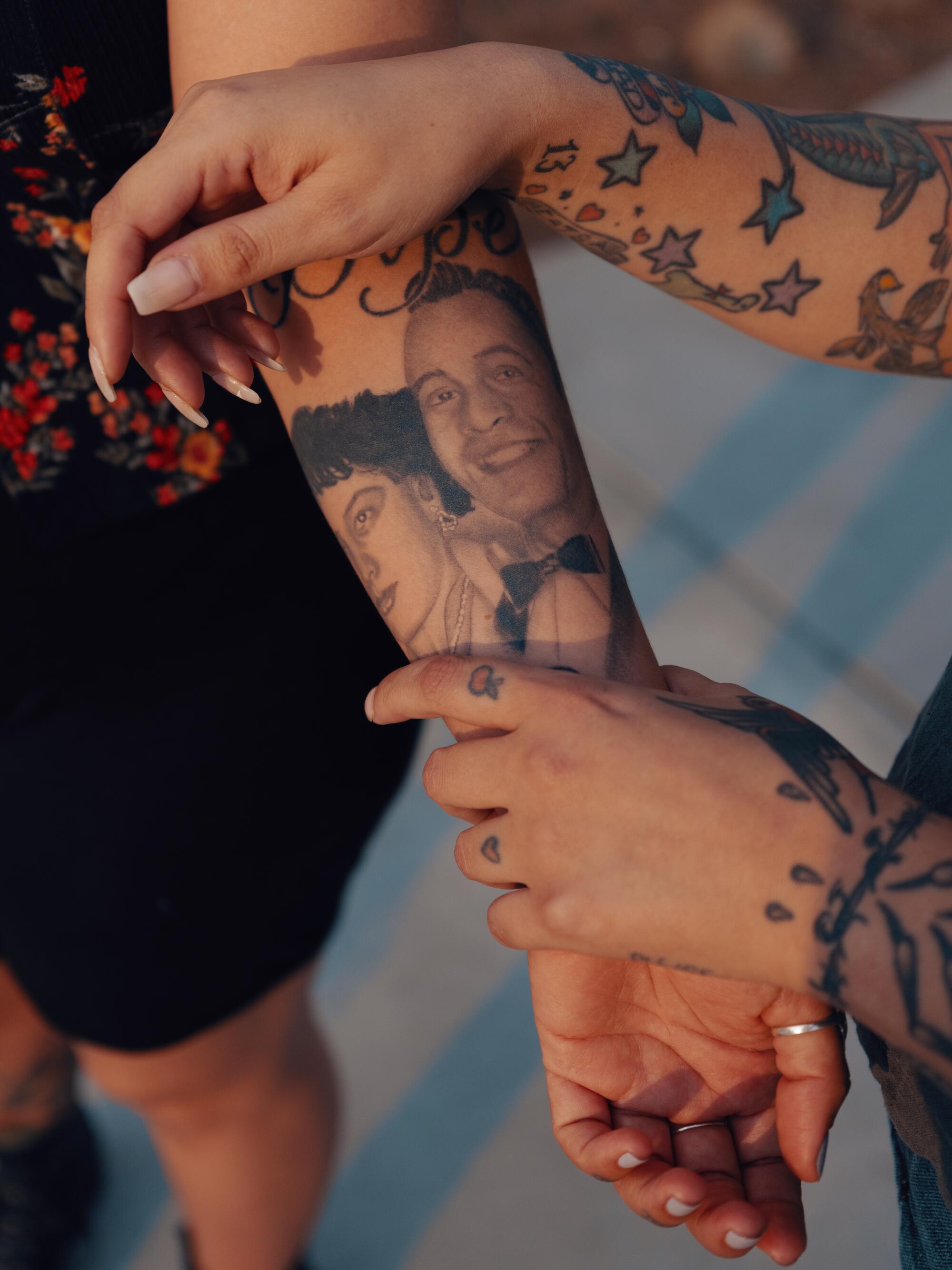
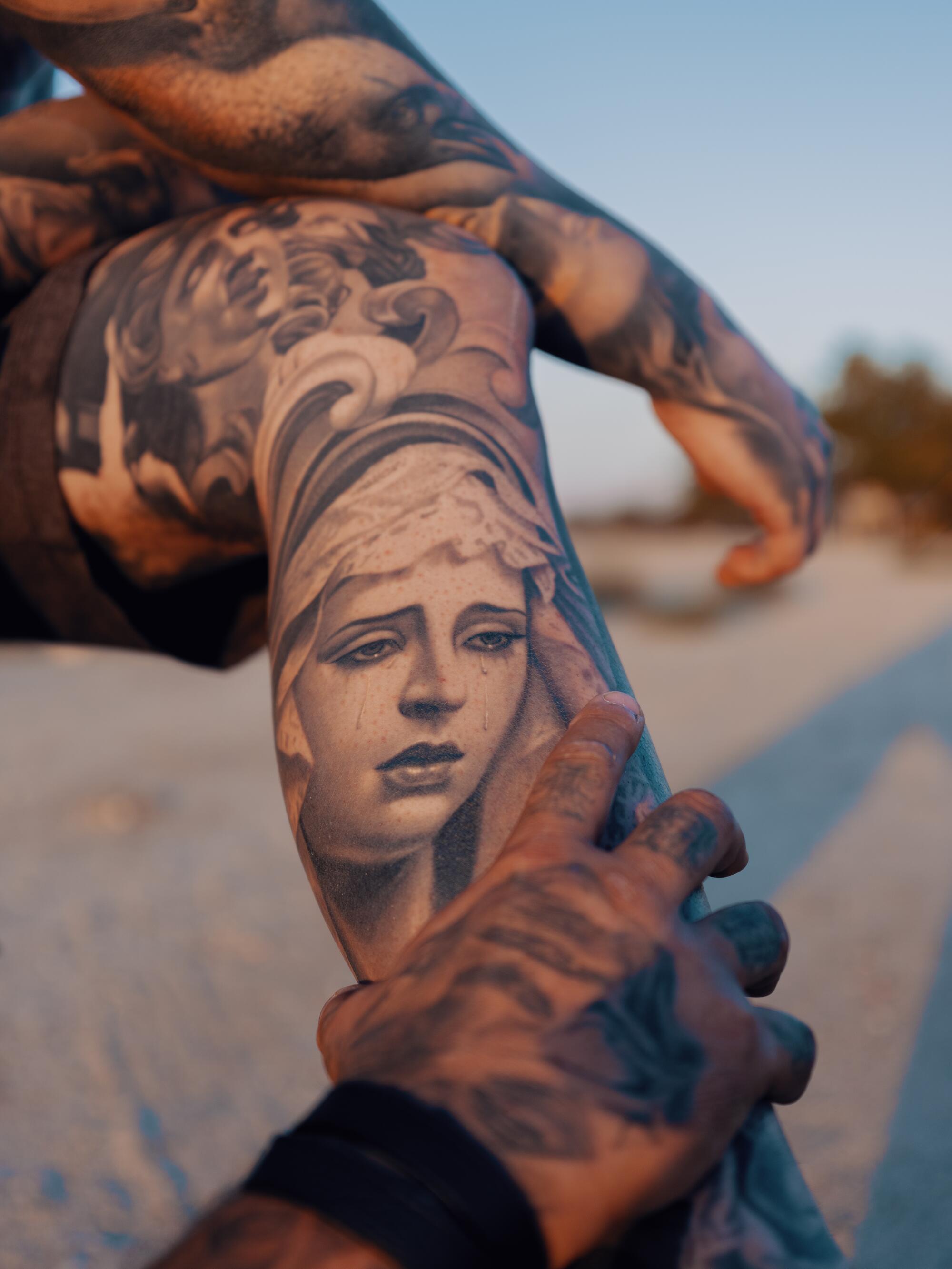
Hurtado, Butcher and Salinas have all had — or have — a foot in the fine art world. Both Salinas and Butcher are trained fine artists and Hurtado still actively moonlights as an oil painter, mostly doing portraits. He doesn’t see one version of portraiture as more valuable than the other — just valuable at different times and for different reasons.
“Tattoos are for the living — but once they die and it’s gone, those things are gone forever,” Hurtado says. “But for oil painting and things that are tangible and you can hold and that will exist a long time — in my opinion, that’s for my death. Whether they end up in a thrift store or my kids own it. I just think that that’s for after I’m gone. It’s going to stay here.”
Bodies are impermanent; muscles wither, skin ages. What we put on our bodies in the form of ink — despite the warnings from our parents to the contrary — wears over time just as we do. The irony is that portrait tattoos — our attempts at preserving another person through permanent ink on skin — live on bodies that are vulnerable to time, decomposing every passing second. Nothing is as forever as it seems, but with portraits we try to screenshot something forever, to hold it close.
Usually, when people come to Salinas for a portrait tattoo — memorial or not — they bring in a photo of their loved one or icon as a young person. It is both a point of reference and an offering: This is how the client wants this person’s face to be remembered on their skin for all of time. This is how they see them in their mind’s eye: At their most human level. Glowing. Multidimensional. Alive. Full of love.
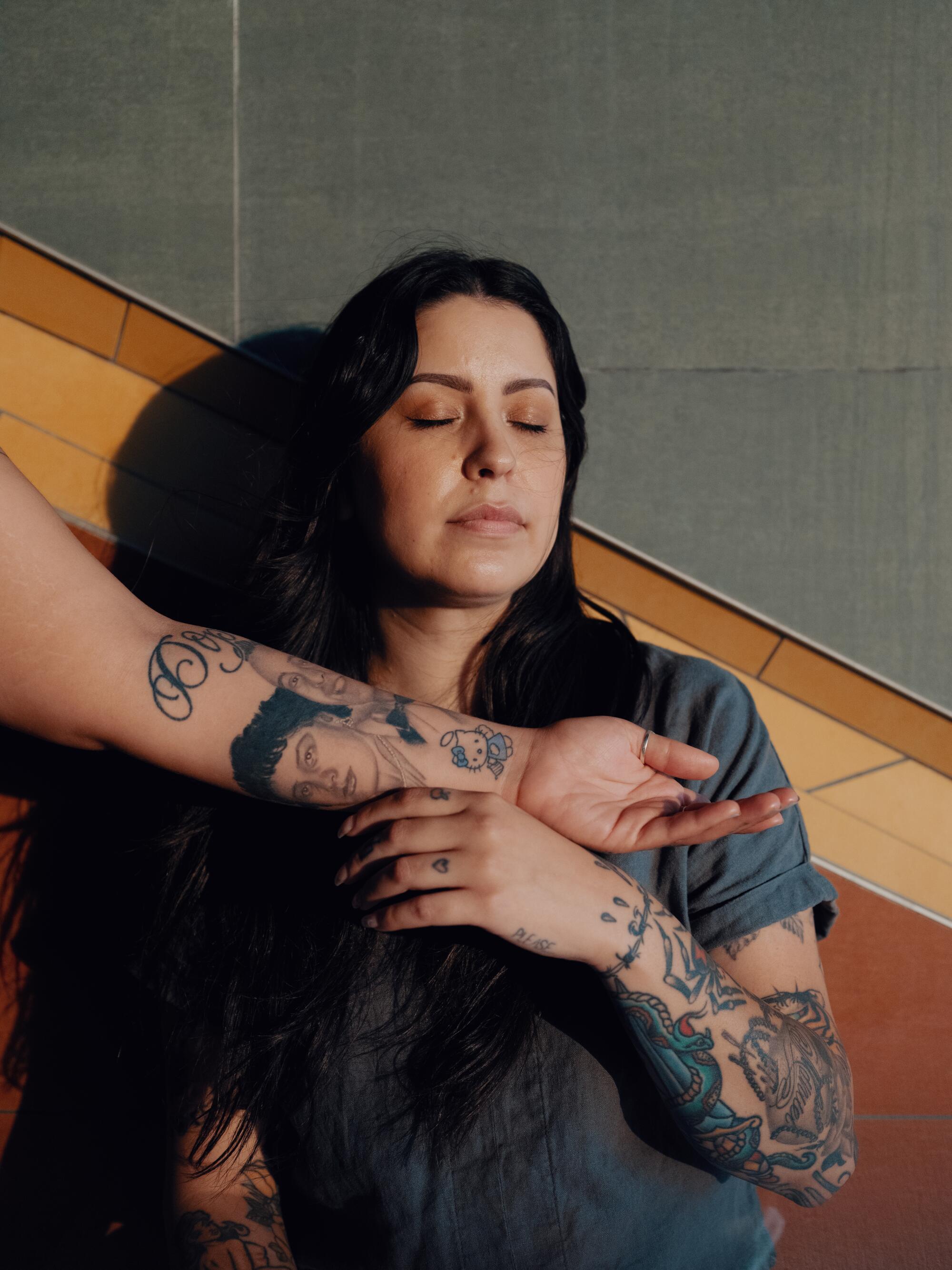
“We keep photographs. We keep photo albums. We keep photos on our phone. Even when we’re on Instagram and we’re scrolling, we’re liking selfies,” Salinas says. “People ultimately need each other to survive, we need each other for love, we need each other for all kinds of things. When people get a portrait tattoo, it’s just another way to preserve the love that they have for somebody.”

